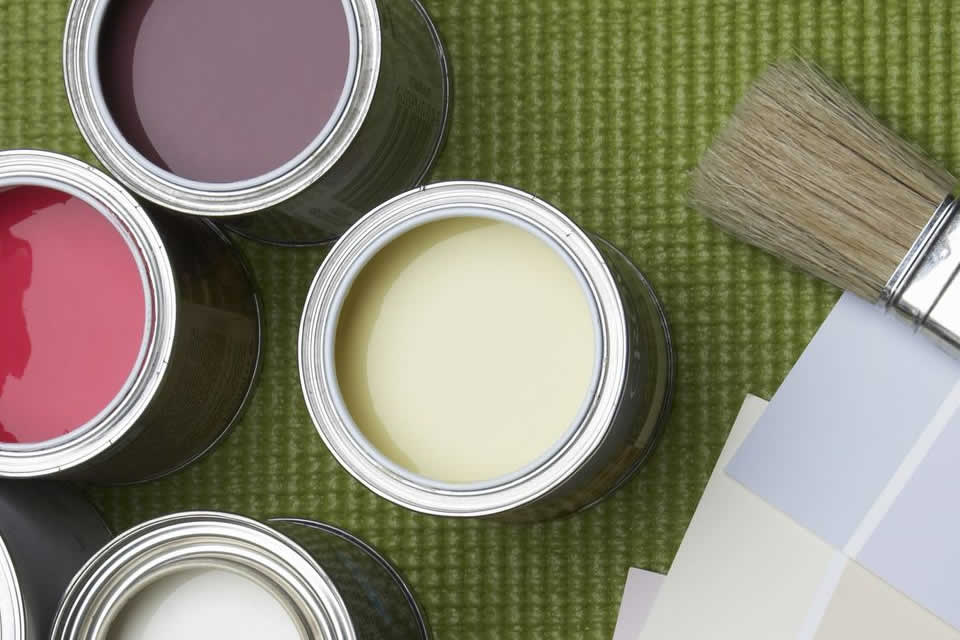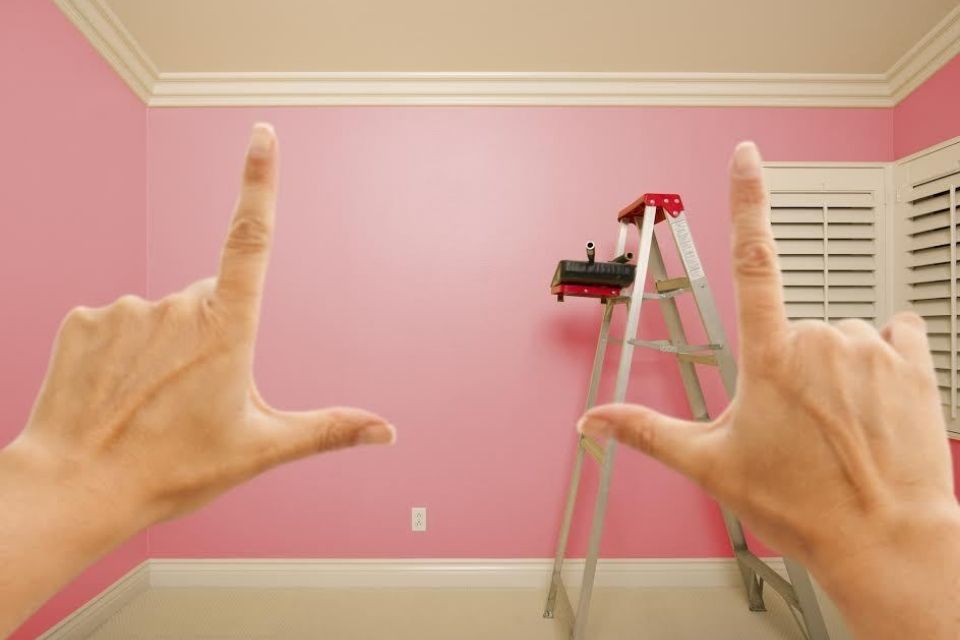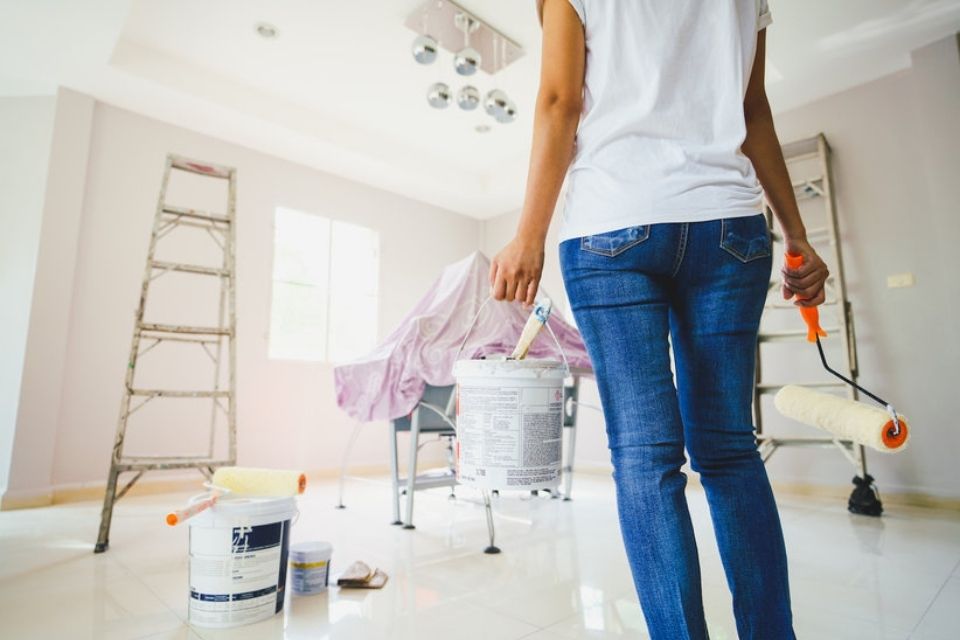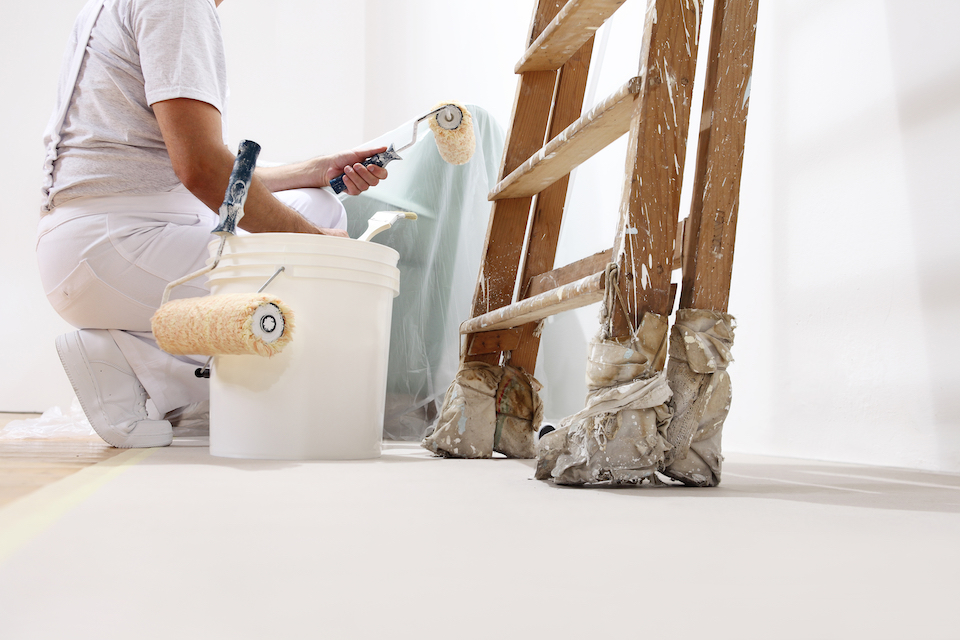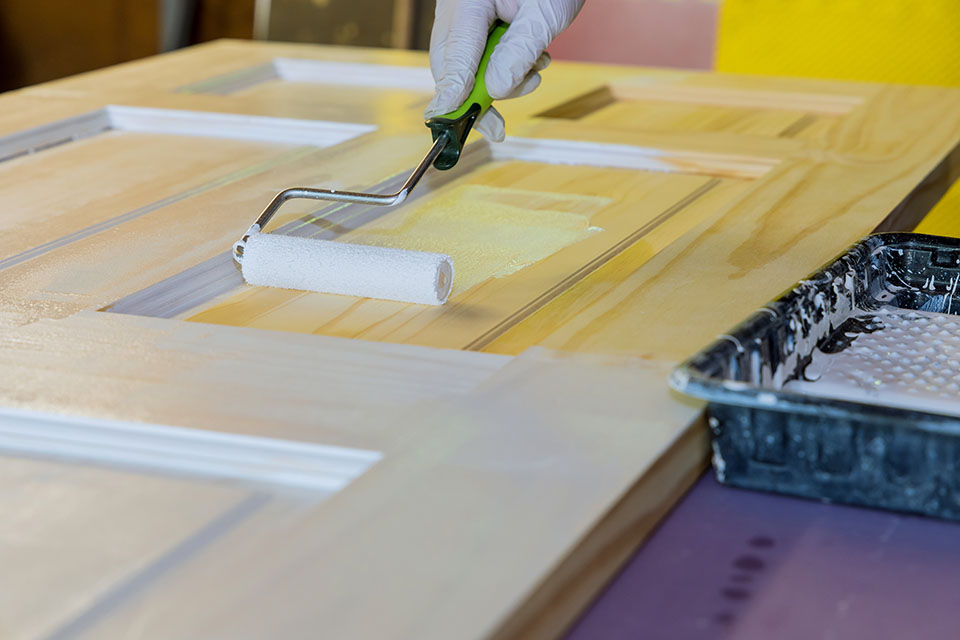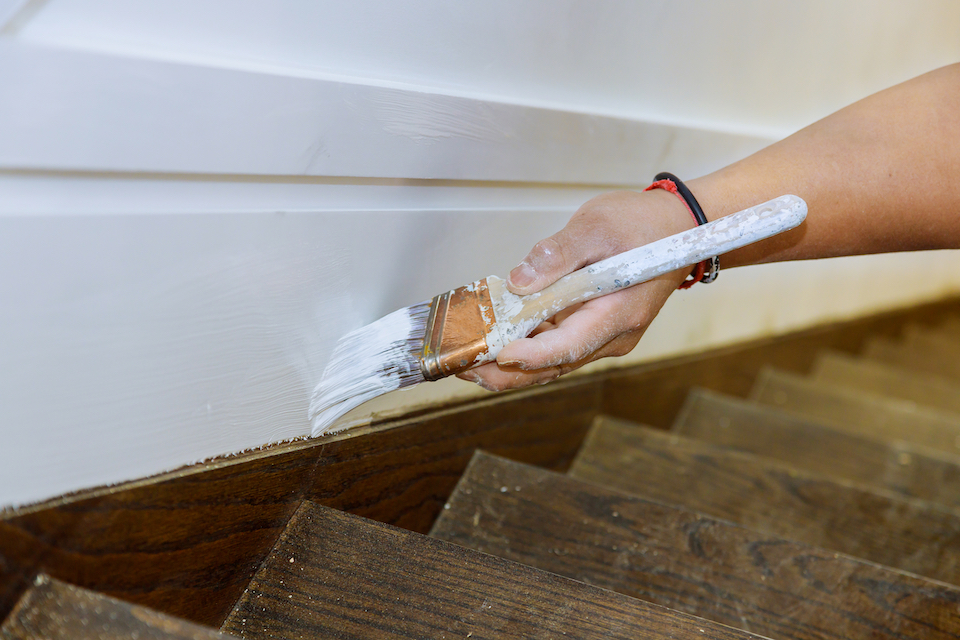Best Paint for Walls
Whether you are moving into a new home with unpainted walls or your old paintwork needs to be spruced up, you need to make sure that you choose the right paint for your interior walls. There are various types of wall paint to choose from including:
- Best Paint for Walls
- Best Paint for Kitchen Cabinets
- Best Paint for Wood
- Best Paint for Skirting Boards
- Best Paint for Bathroom Ceiling
- Best Paint for Radiators
- Best Paint for Damp Walls
- Best Paint for MDF
- Best Paint for Painting Over Varnish
- Best Fence Paint
- Best Decking Paint
- Best Garage Door Paint
- Best Garage Floor Paint
- Best Floor Paint
- Best Shed Paint
- Best Masonry Paint
- Best Metal Paint
- Best Fabric Paint
- Best Tile Paint
- Best Plastic Paint
- Best Window Frame Paint
- Best Front Door Paint
- Best Paint for Stairs
- Best Spray Paint
- Best Washable Paint
- Best One Coat Paint
- Best Anti-Mould Paint
- Best Anti-Condensation Paint
- Best Emulsion Paint
- Best Gloss Paint
- Best Satin Paint
- Best Chalk Paint
- Best Paint Applicators
- Best Paint Removers
- FAQs
- Sources
Best Paint for Kitchen Cabinets
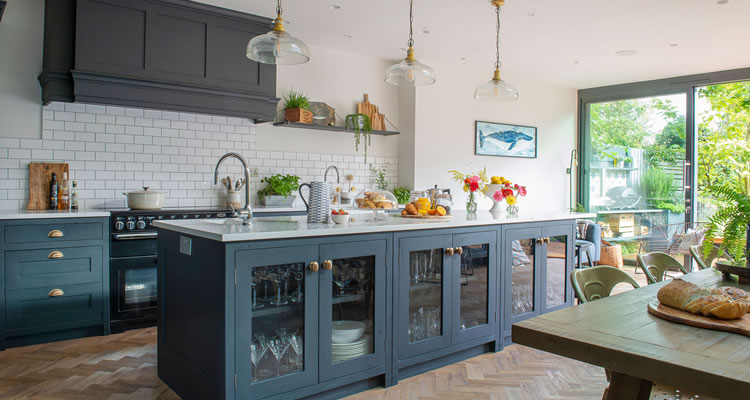
When decorating your kitchen, you should consider which paint will complement your kitchen cabinets. To help you decide, here is a breakdown of the different kitchen cabinets paints:
Satin paint
Satin or satinwood is a type of paint finish which offers a pearl-like sheen. It is normally applied to wood and stainless-steel kitchen cabinets and costs around £10 to £30 per litre.
Pros
A satin sheen is one of the easiest paint types to apply, especially on wooden kitchen cupboards. It also provides a happy medium, as it is not too shiny or flat, which is why it is a popular option for kitchen units.
Cons
One of the main disadvantages of a satin finish is that it does not hide imperfections well, so any touch-ups will not be effective.
Semi-gloss paint
A semi-gloss finish is similar to satin paint; however, it offers more of a sheen and is technically a light reflecting paint. Semi-gloss paint for kitchen cupboards tends to be priced at £8 to £35 per litre.
Pros
Semi-gloss paint is perfect for kitchen cabinets, as it is extremely easy to clean and is also very durable, so they are ideal if you have children. They also offer a pristine aesthetic due to its shiny surfaces which is more subtle than high gloss.
Cons
Like any shiny surface, it will show imperfections, so you need to make sure that the surfaces are prepared properly before painting which will take a lot longer than other applications. If you do have any damage after painting, you may have to pay out to replace your cupboards.
High-gloss paint
A high-gloss finish is one of the shiniest paint options available, which reflects light and creates a mirror-like aesthetic. The average cost of high-gloss cabinet paint is around £5 to £30 per litre.
Pros
High-gloss kitchen cupboards create a bright and shiny aesthetic in your kitchen. It also reflects light and enhances space even in the smallest kitchens. High-gloss is also very durable paint and it is also low-maintenance, as it is very easy to clean.
Cons
The shiny surfaces created by applying high-gloss paint show up smudges and scratches more than other types of paint. High gloss is also hard to repair if there any scuffs on the surface.
Best Paint for Wood
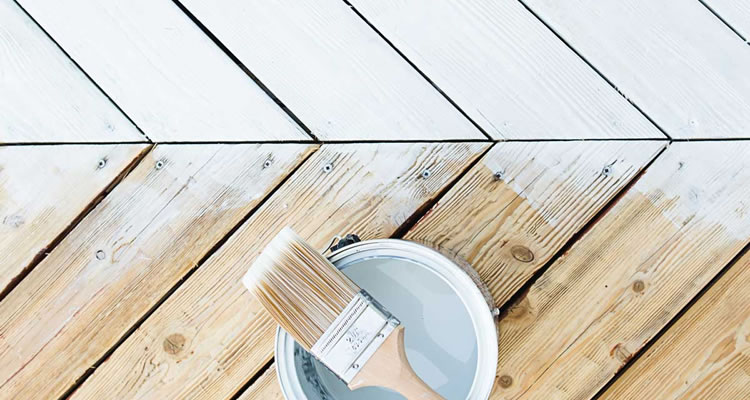
If you have any wooden surfaces that need touching up, then there are various paint types you can choose from which will protect the wood and improve its appearance.
Oil-based paint
Oil-based paint is arguably the best paint for wood. It is normally made up of linseed oil or other synthetic oils. The average cost of oil-based paint is typically around £10 to £25 per litre.
Pros
Oil-based paint is ideal for wooden fixtures such as cladding, as it is not susceptible to scuffs or serious damage, while also offering temperature and humidity resistance.
Cons
The main disadvantage is the time it takes to paint, as the drying time is much longer than other paint types. Oil-based paint can also be prone to splitting when applied to wood, as it tends to contract.
Latex paint
Latex or acrylic paint is a water-based solution containing acrylic and vinyl material. This is typically used to re-paint wooden furniture and tends to cost around £5 to £15 per litre.
Pros
The great thing about using latex paint on wood is that furniture is that it is extremely easy to clean, and also have the advantage of not yellowing over time. Latex paint also dries quickly so there’s no need to wait a long time for it to cure. It is also a lot more eco-friendly than other paint types, as it does not release as many harmful toxins.
Cons
In comparison to oil-based wood paint, latex paint is not as durable. It also requires more work, especially when changing the colour of your wood from a dark colour to a lighter shade, as this will require at least two coats of paint.
Water-based decking paint
Decking paint which is water-based is one of the most popular options for timber decking and tends to cost around £4 to £10 per litre.
Pros
Water-based paint is the easiest solution to use when painting garden decking, as you will not have to apply a pre-treatment to the wood. It also dries and cures quickly, so you will only have around 1 to 2 hours before you can stand on your decking.
Cons
When using a water-based decking paint, you will need to be careful as it is important that great care is taken to ensure that the solution works to protect your decking. This is because water-based paints do not penetrate the wood as well as other solutions, although they are more durable in the long run.
Best Paint for Skirting Boards
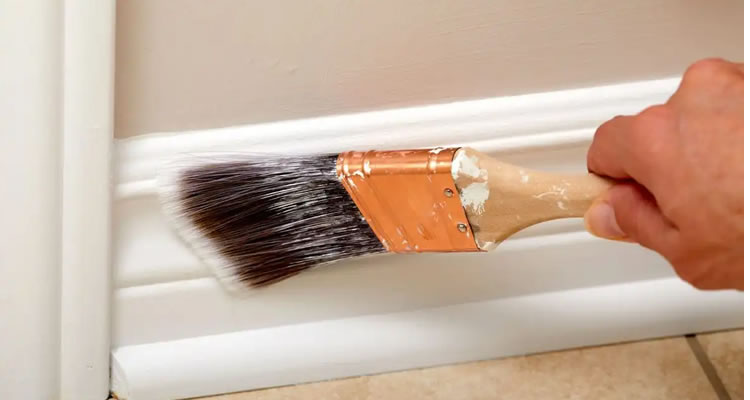
The finishing touches, such as skirting boards are just as important as the rest of room, therefore it is important to choose a paint that is best suited to your skirting boards to spruce up your décor.
Gloss paint
Gloss paint is one of the most popular choices for skirting boards, as it helps to create a shine to rejuvenate even the oldest skirting boards. The average price of this type of paint is around £8 to £35 per litre for semi-gloss and £5 to £30 per litre for high gloss.
Pros
Gloss is the go-to option for many due to its extensive durability and attractive sheen, which makes skirting boards look brand new. If you have children or a significant amount of foot traffic, then this is the perfect choice, as it is resilient and will last for years.
Cons
A downside of choosing a gloss paint is if your skirting boards are significantly damaged, then these imperfections will show up when painting over it with gloss paint. This may mean you have to replace or repair your skirting boards before they can be painted.
Satin finish paint
Satin paint is a more subtle option for skirting boards which works well with bold wall colours. Satin finish paint tends to cost around £10 to £30 per litre.
Pros
Satin finish skirting boards work well in modern homes where striking colours are used. This type of paint is also easy to maintain and can cover up imperfection on your skirting boards if you use a plastic-based satin paint.
Cons
If you choose an oil-based satin finish, then this will not last as long and will also show up any damage on your skirting boards, so you would need to fix this before painting.
Eggshell finish paint
Eggshell paint is a type of matte finish which has a slight sheen and is a step up from a flat finish. The average price of eggshell paint is £13 to £25 per litre.
Pros
This type of paint is ideal for areas with a high level of foot traffic, as it is resistant to scuffs and other damage. It is also great if you are looking for a more understated design for your skirting boards as it offers a bit of decoration.
Cons
The main disadvantage of eggshell paint is that is hard to touch-up, which means imperfections will show easily. This will result in your having to repaint the entire skirting board to ensure it all matches.
Best Paint for Bathroom Ceiling
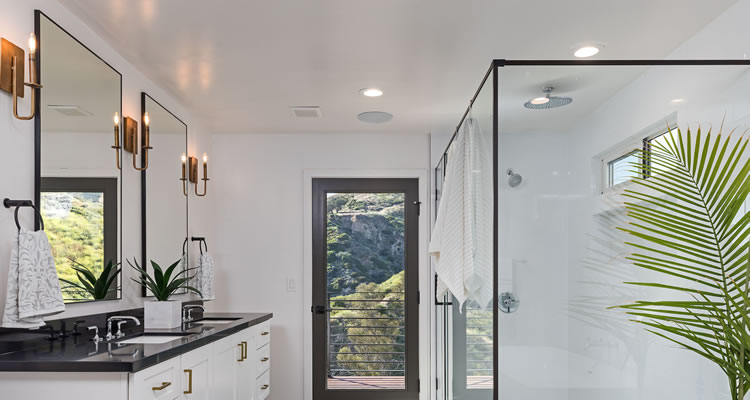
Your bathroom ceiling will need to be repainted if there is a build-up of condensation, as this can cause a build-up of mould which is not only unsightly but also dangerous. To ensure your bathroom ceiling is safe and aesthetically-please, you should consider using the following paint types:
Anti-mould paint
This type of paint is ideal for a bathroom ceiling, which is prone to condensation as anti-mould paint is completely resistant to mould and mildew, as it contains a fungicide. The average cost of anti-mould paint is around £8 to £15 per litre.
Pros
The most advantage of choosing anti-mould paint for your ceiling is that it stops dangerous mould from growing on your ceiling even when it is exposed to moisture. The majority of anti-mould paint is also VOC-free which means it is much safer and helps to keep the air in your home clean and free from toxins.
Cons
If you have any uncommon mould strains that form on your ceiling, then anti-mould paint may not be effective in deterring it.
Semi-gloss ceiling paint
Ceiling paint with a semi-gloss finish is a popular choice for bathrooms for practical and aesthetic reasons. The average of semi-gloss paint is around £8 to £35 per litre.
Pros
The main advantage of using a semi-gloss paint for your bathroom ceiling is that it is one of the most durable options and therefore protects against damage from moisture. It is also mildew-resistant, making it one of the most practical and safe options, which is also easy to clean.
Cons
The problem with a semi-gloss finish is that it can actually reflect too much light, which can change the appearance of your existing bathroom décor that you may not like. It is also not easy to touch up semi-gloss point, so any imperfections will show through the paint.
Acrylic paint
Acrylic paint is a modern solution commonly used to redecorate bathroom ceilings. This type of paint is normally priced at £5 to £15 per litre.
Pros
A major benefit of acrylic paint is that it has a low odour and is therefore much safer to use, while also helping you to reduce your carbon footprint. It is also ideal for areas with high condensation levels such as the bathroom, as it is resilient to peeling and cracking.
Cons
To ensure your bathroom ceiling looks good, you will need a lot of acrylic paint to ensure that it looks consistent. Light-coloured acrylic paint is also susceptible to staining.
Best Paint for Radiators
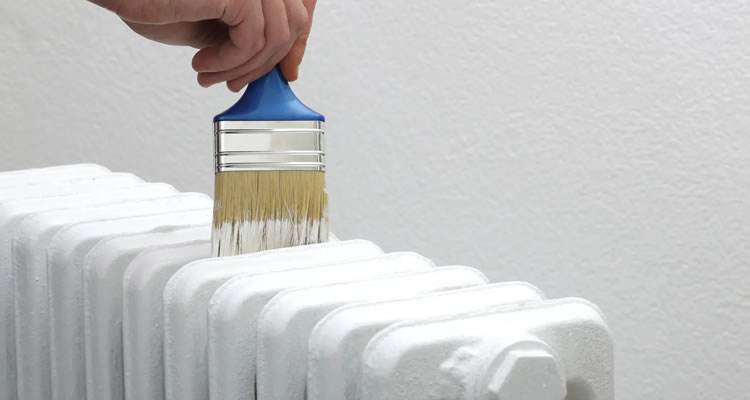
If your radiators need a new lick of paint, then you will need to choose an appropriate paint from the following options:
Metal paint
One of the best options for radiators is metal paint due to its heat-resistant qualities. You should expect to pay around £12 to £50 for a litre of metal paint.
Pros
Metal radiator paint is advantageous as it has extensive heat-resistant qualities, so it will protect the radiator regardless of the temperature. Some metal paints can also be applied over rust, so there is no need to remove it before painting.
Cons
One of the main problems with metal paint is that it can be hard to apply, as formulas tend to be thick. This means that it will take more time to paint the radiator, and you will have to throw out your brushes after, as it is nearly impossible to remove metal paint from an average paint brush.
Heat-resistant Paint
Heat-resistant paint is ideal for metal radiators, as they can withstand temperatures up to 750 degrees. The average price for heat-resistant paint is about £16 to £25 per litre.
Pros
The main advantage of a heat-resistant paint is that even at a radiators hottest temperature the paint can withstand any damage. The majority of heat-resistant paints are also able to prevent rusting.
Cons
The smell of heat-resistant paint can be overwhelming so it makes the application harder and the room will need to be ventilated. You may also have to apply two coats of paint as the texture of heat-resistant paint tends to be runny.
Spray paint
One of the most practical ways to paint a radiator is by using spray paint, which costs around £6 to £8 per bottle.
Pros
Using spray paint on your radiator will ensure that the finish is long-lasting and can withstand damage. It also offers extensive heat-resistance up to 750 degrees, so it will not be affected even if your radiator is on the highest setting.
Cons
Spray painting can be a messy procedure, so to avoid getting paint on your walls, you will need to remove your radiator, which can be time-consuming.
Best Paint for Damp Walls
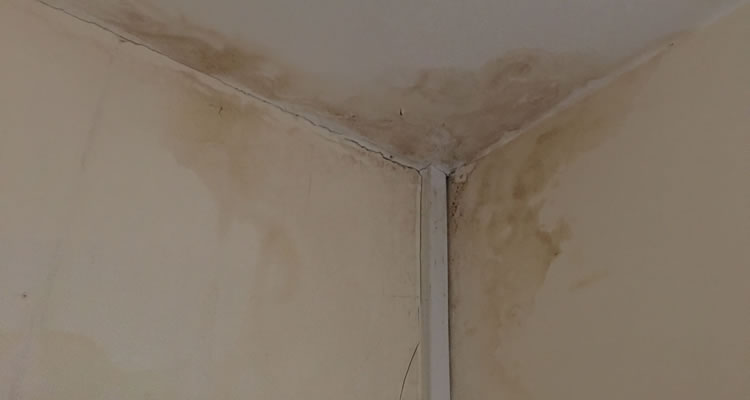
If you have a damp issue which has penetrated your walls, then you should try to use the following paint types to help combat the problem:
Damp-proof paint
Damp-proof paint is ideal for damp walls, as it is normally used as a primer to trap moisture and prevent damp from damaging your walls. Damp-proof tends to cost around £15 to £20 per litre
Pros
The main advantage of damp-proof paint is that it reduces the resurfacing of damp, as it acts as a barrier to prevent moisture entering the walls. Damp-proof paint is also easy to apply and maintain, so it will save a significant amount of time and money.
Cons
If too much damp-proof paint is applied, then this can cause the surface to become wet, which will prevent it from protecting your walls.
Anti-condensation paint
Anti-condensation paint acts as a type of insulation for your walls, protecting it against damp and any other damage caused by moisture build-up. This type of paint costs around £16 to £25 per litre.
Pros
Anti-condensation paint can prevent all moisture problems including mould, discolouration, and staining. If you choose a water-based product then it will also be very easy to clean and maintain.
Cons
Anti-condensation paint may not be the best job for big projects such as the entire house, so you are best sticking to one wall or one room where damp is an issue. It also requires at least two coats and can be quite difficult to apply.
Best Paint for MDF
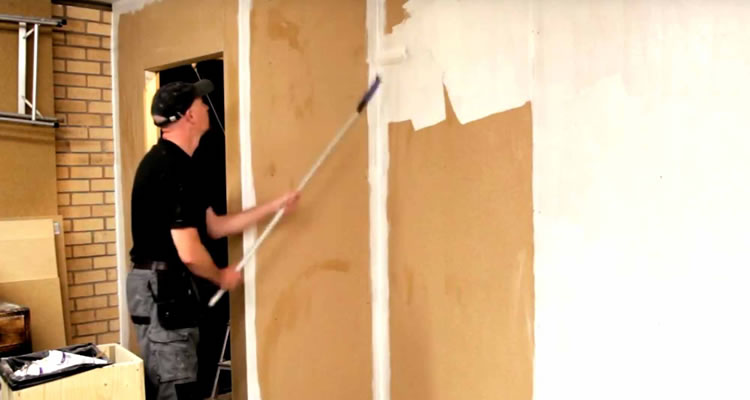
For any furnishings made of medium-density fibreboard (MDF) wood, you will need to find the right paint to ensure that the material is long-lasting and secure.
Oil-based MDF paint
Oil-based paint is the preferred choice for MDF applications, as it does not work as well with water-based paints as it absorbs water easily. The cost of oil-based paint is usually around £10 to £25 per litre.
Pros
The main advantage of oil based MDF paint is that it is extremely durable, and will, therefore, protect the MDF material from scrapes or scuffs. It is also able to withstand adverse temperatures, which again prevents damage.
Cons
Oil-based paints can be hard to apply, as the strong odour that it emits may delay the process, so you will need to make sure that the room is ventilated properly to prevent toxins from lingering in your home.
Acrylic MDF paint
OiA popular alternative to oil based MDF paint is acrylic MDF paint, which can be used as a primer and a topcoat. Acrylic paint tends to cost around £5 to £15 per litre.
Pros
The main advantage of choosing an acrylic-based MDF paint is that it dries quicker than oil-based paint, which means your project will not take long. It is also very easy to clean due to its water-based solution.
Cons
Acrylic or latex paint may be more expensive as you will have to buy more to ensure that the MDF has full coverage and is protected.
Best Paint for Painting Over Varnish
If you have any varnished furnishings which starting to wear away, then it is possible to paint over it as long as you use one of the following types of paint:
Chalk paint
Chalk paint is a decorative paint which has a matte finish and is normally used on furniture and varnish. The average cost of chalk paint is around £20 to £60 per litre.
Pros
Chalk paint is perfect for any DIY enthusiasts as it is easy to apply, and it also hides any imperfections very well, so your varnished furnishings will look brand new. It also dries very quick and as there is no need for primer, the application will not take long.
Cons
The problem with chalk paint is that it is extremely thick so it does tend to leave brush marks so it might not be as neat as oil-based emulsion. It can also build up quickly so it may not look as good.
Oil-based emulsion
Pros
Using an oil-based emulsion over vanish will help to boost the colour and richness of the varnished furnishing you are painting. It is also extremely robust so it will keep your varnished furniture looking brand new.
Cons
Oil-based paints tend to take up to 8 hours to dry before another coat can be applied, so it can be a time-consuming job. It also has a strong smell which can affect the air quality in your home, if you do not leave the doors open.
Best Fence Paint
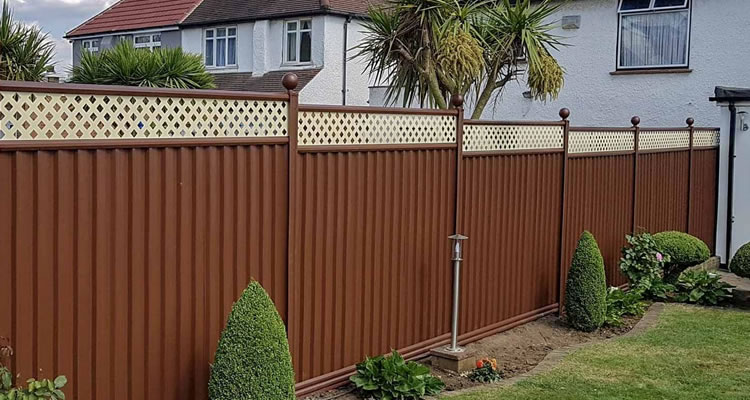
Garden fences needed to be painted every couple of years or so, as weather and other factors can chip away the paint and ruin the aesthetic. Before painting your fences, you should consider which paint is the best.
Latex fence paint
One of the best paint options for garden fencing is high-quality latex paint which protects fencing and costs around £5 to £15 per litre.
Pros
The benefits of using latex or acrylic fence paint is that the acrylic material acts as a moisture barrier to protect your fences from becoming damp and prevents rotting. In comparison to other paint types, acrylic paint is also much more flexible so it can accommodate when your fences start to contract and move in the summer months.
Cons
If painting all your fence panels, you will need a lot of acrylic paint as it requires multiple layers to maintain good consistency while also making sure it looks good.
Exterior wood paint
Exterior wood paint is designed for all timber fencing installations to ensure that it has a long lifespan. This type of paint costs around £0.50 to £25 per litre
Pros
Investing in the best paint for wood will ensure that your fences are easy to clean, and it will also hide any imperfections. It will also protect your fences from the elements as any rotting issues.
Cons
The problem with wood paint is that it can trap moisture that causes the timber to contract which can result in the paint flaking off after a while. Your fences may also be harder to maintain, as your fences may need to be painted regularly.
Best Decking Paint
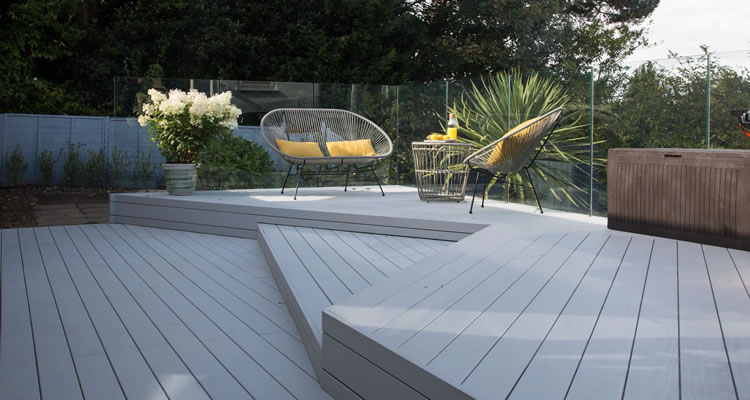
Garden decking is the perfect addition to any garden; however, it does need to be painted regularly to maintain its appearance. To help you enhance the look of your decking, you should use the following paint:
Anti-slip decking paint
Anti-slip paint is normally made up of epoxy resin which is the perfect protective coating for garden decking. The cost of anti-slip decking paint is around £4 to £8 per litre.
Pros
The most obvious advantage of choosing anti-slip decking paint is that it can make your decking safer by avoiding accidents with its resistant surface. By applying this paint, you can also extend the lifespan of your decking, as it will protect against damage.
Cons
Anti-slip paint has quite a short lifespan, especially If the decking is not prepared properly, then this can reduce the efficiency of the anti-slip paint, which will result in you having to repaint or even replace the decking. It is also time-consuming to apply anti-slip paint, as it can take up to 4 days to complete.
Decking oil
Decking oil is used to penetrate timber decking which allows it to protect the installation from the inside. The average cost of decking oil is normally £8 to £16 per litre
Pros
Decking oil is water-resistant so it prevents any damp from damaging your decking when hosing or during heavy rainfall. The majority of decking stains also feature UV protection, so it prevents damage from the sun’s rays.
Cons
The majority of decking oils are not suitable for exotic hardwood decking as they are oily and grainy woods which are not compatible with further oil being added to its surface. The colour you buy may also differ to what it looks like on the tin, as decking oil tends to change colour once it is applied and cured.
Decking stain
Decking stain is similar to varnish which lays on top of the surface to protect the decking. The price of decking stain is usually around £8 to £12 per litre
Pros
Adding decking stain will provide a shielding surface layer which will ensure that your decking is fully protected and highly durable. Unlike decking oil, you can actually change the colour of your decking and there are a variety of different shades available.
Cons
If the seal is broken on the decking stain layer, then this can cause it to flake off and allow moisture to penetrate the timber. It is also hard to install on top of oiled decking, as this will prevent the decking stain from sticking properly.
Best Garage Door Paint
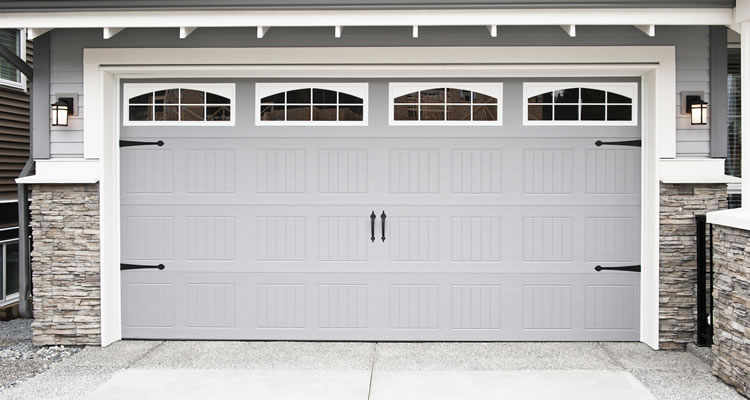
If your garage door is looking worse for wear, then you may want to consider repainting it. Before doing this, you need to choose a paint that is right for your garage door.
Galvanized metal paint
If you have a metal garage door, then one of the best options is galvanized metal paint which will look great and prolong your garage door’s lifespan. The average cost of metal paint is around £12 to £50 for a litre.
Pros
Galvanized metal paint is ideal for garage doors, as its temperature-resistant which means it is not affected by UV rays or frost. If you have any damage on your garage door, such as rusting, then metal paint can easily cover this up without making any repairs.
Cons
The application process for metal paint can be quite difficult as the majority of metal paint solutions are thick, which means it will take a lot longer to paint your garage door.
Exterior paint
Exterior paint can be used on any surface that is exposed to weather conditions. The majority of exterior paints tend to be priced at £4 to £20 per litre.
Pros
The great thing about exterior paint is that it is made to withstand adverse weather condition and hot or cold temperatures. It will also protect your garage door from damage such as rusting or scuffs.
Cons
When applying exterior paint, you must take extra care to ensure that you have enough coverage to protect your garage door, which may take a while. Exterior paints also tend to change colour once they have cured, and the colour will also fade over time, so will need to be painted regularly.
Best Garage Floor Paint
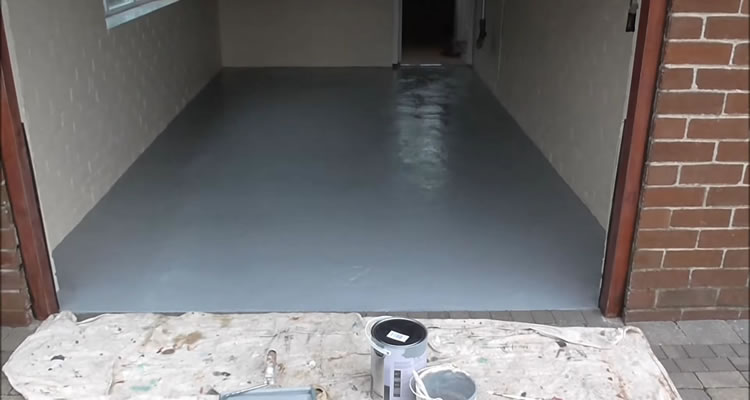
If you want to brighten up your garage floor or want to protect it from harmful substances, painting your garage floor is definitely a worthy option. You’ll need to choose a paint that right for your garage floor. Here are the best paints for a garage floor:
Epoxy Garage Floor Paint
This is a durable garage floor paint, and bonds well with concrete. It will seal the floor well and resist any damage or chemical stains. It can be expensive at £50-£70 per tin.
Latex Garage Floor Paint
Another great contender for garage floor paint, is latex paint. This is a quick drying paint that can be used both indoors and outdoors but may not be as durable as epoxy paint. You can expect to pay around £20-£50 per tin.
Acrylic Paint-
Acrylic paint is the cheapest garage floor paint at around £10-£30 per tin. It covers a garage floor with ease but can take longer to dry and be less durable.
Applying garage floor paint with a long roller is usually best. Make sure to give it enough time to dry before walking on it. Always read the manufacturer’s instructions before use.
Best Floor Paint
If you want to update a room, add some colour or create a unique interior design feature, painting the floor can do that for you. It does depend on what type of floor you have whether you can paint it or not. For example, if you have gloss-laminate, it’s not recommended you paint over it. If you’ve got hardwood flooring, painting them is ideal. Here are the best floor paints available:
Polyurethane Paint
This affordable paint is great on a number of floors including, wood, concrete and stone. It’s easy to clean and resists stains such as oil and grease. You can expect to pay around £20-£50 per tin.
Chalky Floor Paint
If you’re looking for something aesthetically pleasing, chalky floor paint is a great option. It’s perfect for bedroom areas, but may not be great for bathrooms and kitchens, as water can wash it off. This pain is cheap and can be as low as £10-£20 per tin.
There are lots of floor paints out there, depending on what type of finish you’re looking for. Make sure to test paint on a small section of flooring first, to see whether it’s what you want.
Best Shed Paint
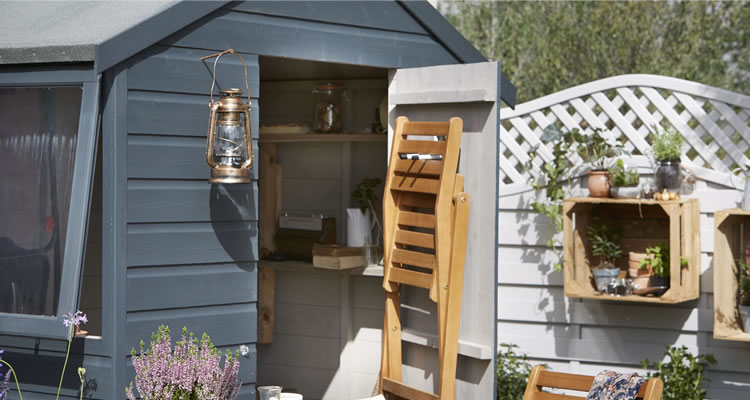
If you’ve recently had a new shed built that needs painting or you want to change the colour of an old shed, then you need to consider which type of paint you need, including:
Exterior high gloss paint
If you want your wooden shed to stand out, then the best paint for woodsheds is exterior high-gloss paint which costs around £5 to £40 per litre.
Pros
Exterior high-gloss paint is perfect for enhancing the colour of your shed, while also protecting the wood from damage. This type of paint is also easy to clean, so you can remove any dirt or debris from your shed within minutes.
Cons
One of the main problems with high-gloss paint is that it can show up imperfections, so if you have any damage to your shed, applying a gloss paint might not be the best option. It is also hard to apply, as you must make sure that the right coverage is used to avoid evident brush marks.
Weatherproof paint
Weatherproof paint is ideal for a garden shed, as it will protect it against harsh weather conditions. The average cost of weatherproof paint is around £15 to £30 per litre.
Pros
The main advantage of weatherproof paint is that it is water-resistant, so it will protect your shed during heavy rainfall. It can help to lower humidity, and also protect against UV rays.
Cons
While weatherproof paint can limit damage caused by weather, it does not stop it completely. You may have to use an additional barrier such as a primer or oil to prevent extensive damage.
Best Masonry Paint
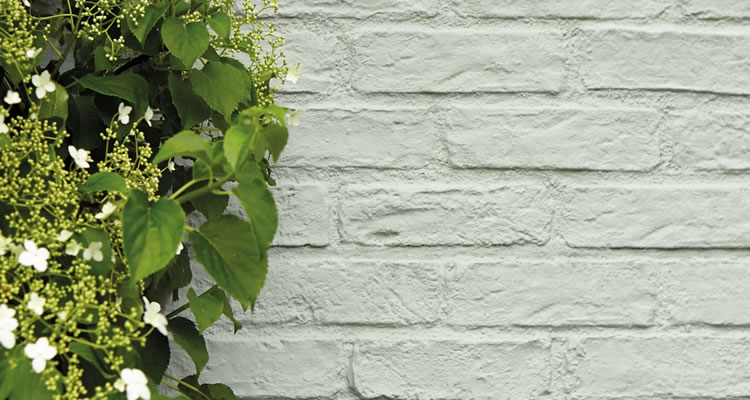
If you wish to repaint the outside of your home or a brick, stone or concrete wall, then you need to make sure that you decide which paint is best for your masonry painting project.
Smooth masonry paint
This type of paint is similar to normal matte interior paint; however, it contains weatherproofing elements which are ideal for rougher surfaces such as pebbledash and brickwork. Smooth masonry paint tends to cost around £3 to £5 per litre.
Pros
The great thing about smooth masonry paint is that it offers a subtle matte finish which is ideal for the exterior of your property and garden walls. Smooth masonry paint is also easy to apply to large surfaces, so it is an ideal choice if you’re planning to repaint your entire house.
Cons
Smooth masonry paint does not cover up damage as well as textured masonry paint. It is not as resilient to harsh weather conditions, in comparison to textured masonry paint, so it may be susceptible to moisture build-up.
Textured masonry paint
Textured masonry paint has a rougher finish in comparison to smooth masonry paint. The average cost of this type of paint is around £3 to £5 per litre.
Pros
Textured masonry paint is good for smooth stone surfaces as it offers an aesthetically pleasing finish. It is also for covering up imperfections such as cracks and scuffs. It also withstands harsh weather conditions due to the tough material.
Cons
The problem with textured masonry paint is that it collects dirt easily, so it will need to be cleaned regularly. It is not ideal for large surfaces, as it is difficult to apply and also hard to clean and maintain.
Best Metal Paint
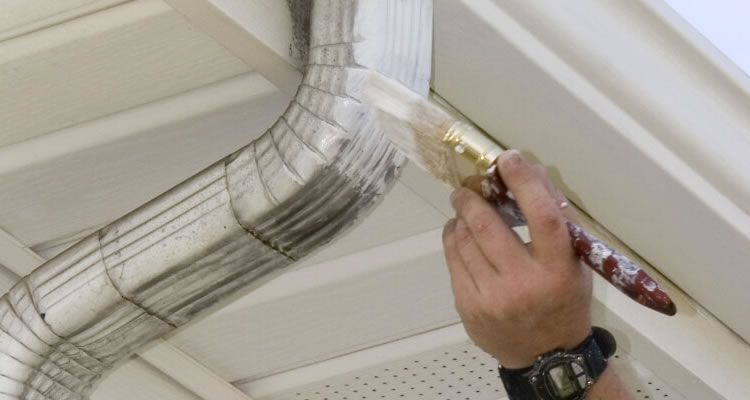
For any metal surface inside and outside your home, you should consider using a metal paint to protect and enhance the surface. There are various types of metal paint including:
Metal spray paint
This type of metal paint is stored in a pressurized container and can be used on a variety of metal surfaces. The cost of metal spray paint is around £25 to £40 per litre.
Pros
Metal spray paint is ideal for smooth surfaces such as stainless-steel cupboards or smooth metal doors. Spray painting is also ideal for large jobs, as it takes a lot less time to use a spray rather than a paint brush or roller.
Cons
The downside of metal spray paint is that it can take a long time to prepare the area, so it is not appropriate for small touch-up jobs. It is also important that any furniture should be protected to avoid damage when spray painting.
Enamel metal paint
Enamel metal paint is typically an oil-based paint which is designed to enhance and protect metal surfaces. The average price for enamel metal paint is usually around £18 to £25 per litre.
Pros
The main benefit of enamel metal paint is that it creates an aesthetically pleasing design which not only looks good but is also extremely durable. This protects the metal surface, while also prolonging the lifespan.
Cons
Oil-based enamel paint can take up to 24 hours to dry completely, so it can be a more expensive job. It also has an overwhelming odour, which makes it difficult to apply the paint, so it is important that you keep the room ventilated while painting.
Best Fabric Paint
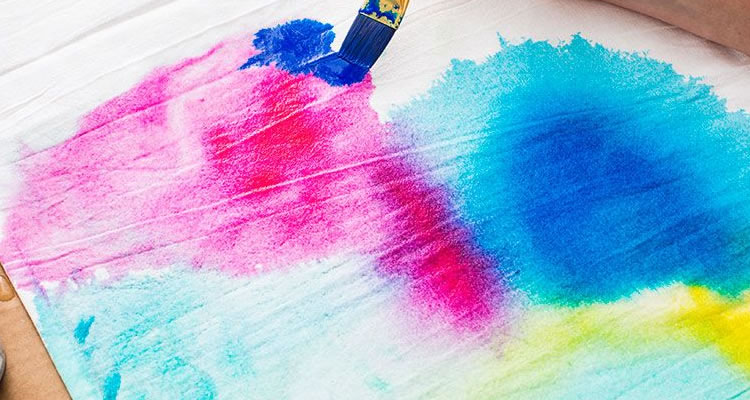
Fabric paint is made up of a binding agent and dye which allows the paint to stick to the fabric. There are various types of fabric paint including:
Acrylic fabric paint
An acrylic fabric paint contains acrylic materials which allow the paint to adhere to the fabric easily. Acrylic fabric paint typically costs around £6 to £15 per kit.
Pros
The great thing about acrylic fabric paint is that it dries quickly. It is also easy to apply, as only thin layers are required on upholstered furnishings. This type of paint is also easy to clean, as it can be diluted with water, without causing damage.
Cons
Some acrylic paints can contain toxins, so you will need to ventilate your home when painting or look for a paint that does not contain VOCs. Acrylic fabric paint can also change colour when it cures so you may end up with a different shade than what It looks like on the bottle.
Liquid fabric paint
This type of paint is similar to craft paint, although it is specifically designed for larger surfaces, such as a sofa or chair. Liquid fabric paint costs around £5 to £8 per bottle.
Pros
Liquid fabric paint can easily be applied straight from the tube or bottle. You can also mix liquid fabric paints together to create different shades and create a unique design.
Cons
Liquid fabric paint is not ideal for small touch-ups, as it involves preparation which not be worthwhile for a small paint job. It can also leave brush marks if using a paint brush, so you try to apply it directly to your furniture if possible.
Best Tile Paint
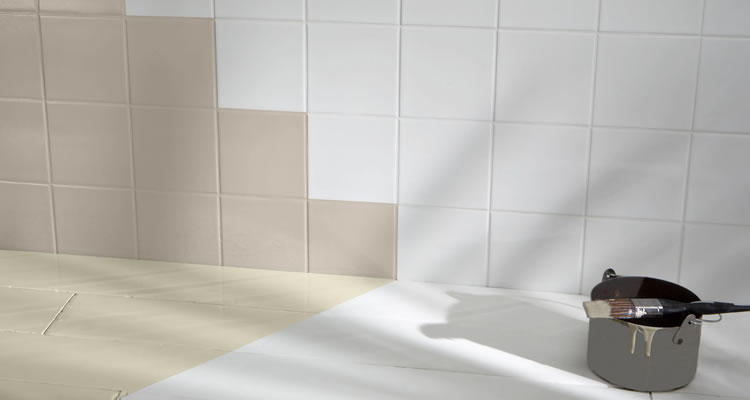
If redecorating your kitchen or bathroom, then you may want to consider painting your tiles instead of replacing them. To help you decide on the type of paint you need, take a look at the following options.
Latex tile paint
Latex tile paint is usually used on ceramic tiles, as it is easy to apply and provides a good finish. This type of paint costs around £5 to £15 per litre.
Pros
Latex tile paint usually contains a resin which helps the paint stick to the tile. It is also easy to apply and tends to dry quickly, so using this type of paint may speed up the process, while also protecting it from water damage due to its waterproofing qualities.
Cons
One of the downsides of choosing latex tile paint is that you may have to take time to prime the area to ensure it is protected before any latex paint can be applied on top of it. Latex tile is also not as durable as other paint types and can wear away over time.
High-gloss tile paint
High gloss is one of the best options for your kitchen and bathroom paint which looks good and is easy to apply. This type of tile paint tends to cost around £14 to £20 per litre.
Pros
The majority of high-gloss tile paints are solvent-based which can cover up any cracks or imperfections on your tiles. This type of tile paint should also be easy to apply if it has a thin consistency.
Cons
If the paint you choose is solvent based then It can have a strong odour which may be distracting during application, so you need to make sure that you open windows and doors or hire a ventilator. It may also change colour after curing so you may want to test it first.
Best Plastic Paint
If you have any plastic furnishings inside or outside your home, such as windowsills or door frames, then you should consider which paint is best out of the following plastic paint options.
All-purpose spray paint
All-purpose spray paint can be used on almost any material including plastic and can be used on interiors and exteriors. This type of spray paint usually costs around £8 to £13 per bottle.
Pros
The most obvious advantage of choosing an all-purpose spray paint is that you can paint your plastic windowsills as well as wooden window frames, which will make your painting project much easier. It is also a quick-drying option, so you don’t have to wait all day to touch the plastic.
Cons
Unless you are applying paint to a smooth surface, an all-purpose spray paint cannot be sprayed until the surface is fully prepared. This may take a long time, especially if you have a significant amount of imperfections on your plastic surface.
Acrylic spray paint
Acrylic-based spray paint is one of the best options to choose from plastic surfaces. The average cost of acrylic paint is around £8 to £12 per bottle.
Pros
Acrylic spray paint is ideal for large surface such as windows or door frames which need touching up or repainting. Using this type of paint will also help you to achieve an even coat even if you are a first time DIYer.
Cons
Spray paint usually releases a strong odour so it is preferred for outdoor use, although you can use it indoors if your home is ventilated. You will also need to wear safety equipment such as a mask and goggles when spray painting.
Best Window Frame Paint
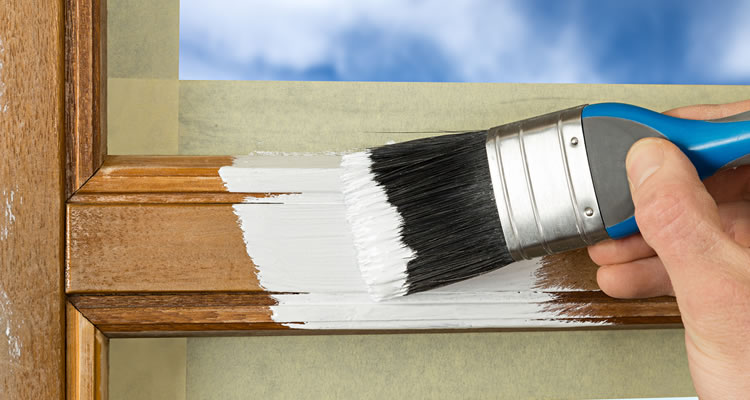
After a while, your window frames may start to look worn down and could do with a lick of paint. The type of paint you choose will depend on whether you have wood or uPVC windows. To help you choose the right paint, take a look at the following guide.
Interior wood paint
If you have wooden window frames, then you will need to use an interior wood paint, which tends to cost around £7 to £25 per litre.
Pros
Wood paint works to protect your window frame, while also enhancing the colour. An oil-based wood paint will also act as a barrier against harsh weather conditions. It is also extremely easy to clean and maintain.
Cons
If using an oil-based wood paint it may take longer to paint and it can also be prone to splitting and cracking, while a water-based solution may not protect it as well as other wooden paint as it does not penetrate the wood as much.
Multi-surface paint
For uPVC window frames, you should use a multi-surface paint which usually costs around £8 to £18 per litre.
Pros
One of the main advantages of choosing a multi-surface paint is that it can be used on your uPVC window frames as well as any wooden or metal parts. It will also provide full coverage and the first layer can act as a primer before the topcoat is applied.
Cons
The problem with multi-surface paint is that it can have a thick consistency which makes it harder to apply. You should also avoid using this type of paint on uPVC, as you should wait at least 12 months before making any changes, as this can damage the window frame.
Best Front Door Paint
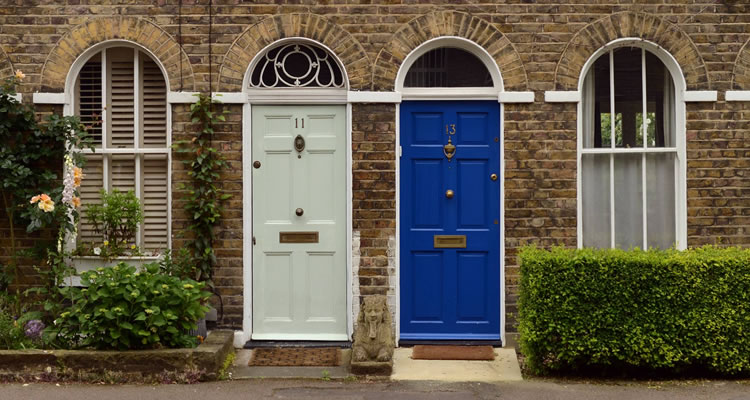
To enhance the look of your front door and improve kerb appeal, you should consider repainting it. To do this, you will need to make sure that find out which paint is best for your door’s material.
Interior wood paint
If you have a wooden front door, then you should use an exterior wood paint, which normally costs around £3 to £8 per litre.
Pros
The great thing about exterior wood paint is that protects your door from the elements, while also enhancing the colour of your door. Using wood paint will also prolong the lifespan of your door, especially if you use an oil-based paint as this will embed into the wood and protect it from the inside.
Cons
The main problem with painting wood is that you will have to prepare the surface properly by rubbing over it with sandpaper. You will also need to fill in any cracks before painting, so the whole process may take a while.
Exterior metal paint
The best paint for a metal door is exterior metal paint, which normally costs about £12 to £50 for a litre.
Pros
When using an oil-based exterior metal paint, you can easily cover up any blemishes on your metal door. You can also benefit from the durability of an oil-based paint that will ensure the paint stays and your door is protected for a number of years.
Cons
If painting over a metal door with peeling paint, then you will need to use a paint stripper and prepare the area before applying the new paint which can prolong the painting project. It may also wear down if any significant damage is caused, so you may want to apply paint regularly.
All-surface paint
If you have a uPVC front door frame, you should choose an all-surface paint which is normally priced at £8 to £18 per litre.
Pros
An all-surface paint is the perfect choice for a uPVC door as it has weatherproofing qualities which make it waterproof and durable against adverse weather. It will also offer good coverage, which means you won’t need as many layers.
Cons
The problem with painting uPVC doors is that the material can contract with high temperature, so this can cause the paint to split or crack. It may also take longer to apply, as all-surface paints are usually thicker.
Best Paint for Stairs
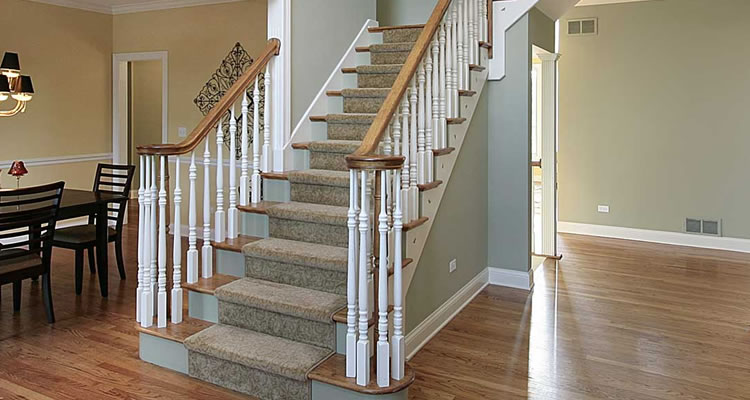
To update the staircase in your home, you should consider changing the colour or simply just rejuvenate it with the same paint. Before painting, you should consider which paint type is best for your staircase by following the below guide.
Wood paint
A typical wooden staircase can easily be painted using a wood paint. The average cost of wood paint is around £7 to £25 per litre.
Pros
The great thing about using wood paint is that it is easy to apply, and it protects the staircase and prevents it from rotting. It can also hide any imperfections such as scuffs or scratches.
Cons
Wood paint tends to trap moisture which will force the wood to contract, leading to splits in the paint and the actual wooden staircase itself. You will also need to be careful when choosing a colour for your staircase, as wood paint is extremely hard to remove, so you need to make sure you select the right shade.
High-gloss enamel paint
Another popular stair paint is high-gloss enamel paint which is the go-to option for metal staircases. The average cost to purchase this paint is around £20 to £35 per litre.
Pros
If you have a steel staircase, you can apply a high-gloss enamel paint to rejuvenate the colour of the steel. It will also hide any damage which may have been caused by heavy foot traffic, while also protecting it against further damage.
Cons
The painting process for a steel staircase is quite complex as the staircase will need to be prepared with sandpaper and primer before any paint can be applied to the surface. You will also need to apply at least two coats to ensure that the staircase is fully covered.
Best Spray Paint
Spray paint is one of the easiest and cheapest paint types to choose from, however, it is important that you choose a high-quality spray paint that is right for your painting project.
Enamel spray paint
This is an opaque glass material which is used as a glossy protective layer for indoor and outdoor surfaces. This type of spray paint tends to cost around £5 to £8 per bottle.
Pros
The most obvious benefit of using enamel spray paint is that it is extremely easy to apply as it dries very quickly and does not drip. It is also extremely durable as it provides a hard surface layer which protects from harsh weather conditions. It is also resistant to mildew and dirt build-up, so it can also be used inside to combat damp.
Cons
If using an oil-based enamel spray paint, then this can contain harsh toxins which cannot be used indoors without proper ventilation. This will not only reduce the air quality in your home but will also have an effect on the environment.
Stone spray paint
This is a multi-surface spray paint which creates a unique stone design on ceramic, metal and wood surfaces. This tends to cost around £10 per bottle.
Pros
This spray paint can be used for interior and exterior surface in order to improve their aesthetic. It is also very to apply and provides excellent coverage that is long-lasting and unique.
Cons
Before spray painting with a stone spray paint, you need to make sure the area is fully prepared to avoid the paint sticking to dirt or any damaged areas. You will also need to apply a primer when using wood or metal.
Radiator spray paint
This is heat-friendly spray paint which is used specifically for radiators. This type of spray paint tends to cost around £7 per bottle.
Pros
This spray paint is designed for metal radiator surfaces due to its high level of heat-resistance. It is also very easy to apply due to its good adhesive qualities which allow the paint to stick without an undercoat.
Cons
When using this type of product, you need to make sure you wear safety equipment as it does contain toxins that should not be used in poorly ventilated areas.
Best Washable Paint
Washable paint is ideal for homes where spillages are a regular occurrence. To avoid permanent stains, you should choose one of the following washable paints:
Satin finish paint
Satin paint is normally used on wood furniture, doors and windows, while offering a slight decorative sheen. Satin paint tends to cost around £2 to £9 per litre.
Pros
It is quite easy to clean satinwood, as all you need to do is gently sponge off any marks, then wash down the rest of the wall with a damp cloth.
Cons
The problem with satin paint is that it can mark easily so you need to make sure that you do not scrub too hard as this can leave your paint looking discoloured.
Silk finish paint
Silk paint has a similar sheen to satinwood; however, it is normally used on walls and ceilings. This is typically priced at £4 to £8 per litre.
Pros
Due to its reflective finish, silk emulsion is a wipeable paint, as any marks can be removed easily with a soft sponge and a mild detergent. This will not leave any stains and will look brand new once the mark has been wiped away.
Cons
While you can scrub the area, you need to be careful about scrubbing it too hard, as you may remove the decorative shine, which will make the area of the wall or ceiling look dull or out of place.
Eggshell finish paint
One of the easiest paints to clean is eggshell paint which has a low level of shine. This normally costs around £7 to £15 per litre.
Pros
This is a wipeable paint that is so easy to clean, which is why it is used for kitchens and bathroom paint jobs where moisture and splash stains can form on the surface. These can easily be scrubbed away with water and detergent.
Cons
While it is easy to clean eggshell, it can actually be hard to touch-up if a stain starts to cause damage, so you should try to clean it quickly in order to prevent long-term issues.
Best One Coat Paint
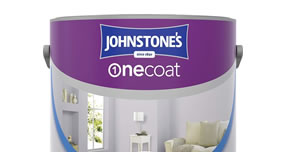
One coat paint is designed for ease as it promises that you only need one coat of paint and the job is complete. Before choosing at random, you need to decide which paint is best out of the following fast-acting paints.
Johnstone’s One Coat Emulsion
This a one coat emulsion with a smooth finish that features an advanced formula that promises the one coat miracle. This can be purchased at your local DIY store for £3 a litre.
Pros
This paint is perfect for hiding any damage or scuffs on your walls or other surfaces, especially if you choose the matte finish. It also has a thick consistency which prevents excessive dripping, and it is also eco-friendly due to its lack of VOCs.
Cons
Applying this paint can be difficult when using a regular paint brush, you may want to invest in a roller to apply it properly without any brush strokes present.
The One Multi-surface
This Rainbow Chalk paint is a two-in-one paint and primer that can be used on wood, uPVC, glass, ceramic, metal and more. This versatile paint costs around £20 per litre.
Pros
This is one of the easiest one paints to apply due to its mixed formula which does not require an undercoat. It also only takes around 2 hours to touch dry, so if you need to make any touch-ups you can after a short while.
Cons
You should be aware that the shade may be different to what It says on the tin, so you should definitely test it on a small hidden area before covering an entire wall.
Polycell Stain Stop
This type of paint helps to cover up stains on masonry, plaster, wood, stone and more. This is normally priced at £25 per litre.
Pros
This paint is perfect for covering up any grease, nicotine burns, rust and more. It is also extremely durable to its hardwearing film that acts as a barrier and stops stains from seeping through. It also protects your existing paintwork from further damage.
Cons
Polycell Stain Stop is hard to apply as the formula is extremely thick, so it is almost impossible to prevent brush strokes.
Best Anti-Mould Paint
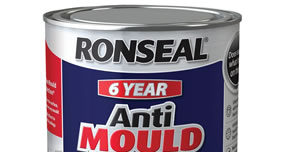
Anti-mould paint contains powerful biocides which prevent the growth of mould. This is required in damp or cold areas where mould is more likely to grow, such as your bathroom or basement. There are so many anti-mould products, although the following are some of the best available.
Ronseal Anti-damp Paint
The Ronseal Anti-damp paint contains a biocide that treats the wall surface and acts as a barrier against mould production. This paint is normally priced at £13 per litre.
Pros
This anti-damp paint comes in a variety of finishes and shades so you can protect your walls while also ensuring they look good. It also provides excellent coverage and only requires around two layers, with the added benefit of drying within two hours.
Cons
This anti-mould paint can be difficult to apply due to its thickness, which causes it to drip. It is also not effective for uncommon mould strains, so you would need to seek professional help on this occasion.
Dulux Easycare Bathroom Plus
This paint works alongside anti-mould paint by suppressing excessive moisture and steam. Dulux Easycare Bathroom Plus should be available at your local DIY store for £8 per litre.
Pros
The most beneficial element of this paint is that it provides excellent coverage and therefore offers you great value for money, as you will only have to paint on two coats. It is also one of the most durable options, as it can be used in high traffic areas.
Cons
This type of paint should not be used on its own to combat damp, as it only prevents moisture build-up and does not contain biocides. You may also need to add paint layers when covering a dark shade.
Thompson’s Damp Seal
If you have damp walls in your home, you should definitely consider using this damp seal, which is priced at £20 per litre.
Pros
The main benefit of Thompson’s Damp Seal is that is has a micro-porous film which traps moisture and prevents damp from entering your walls. It is also ideal for multiple surfaces, so you can prevent damp all over your home.
Cons
This is one of the expensive products available, so if you are on a budget it may not be the best option for you. It may also not solve your damp problems, if you have extensive damp damage before painting.
Best Anti-Condensation Paint
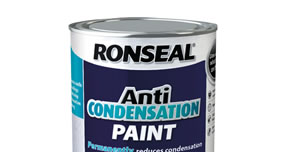
Anti-condensation paint is excellent at combatting condensation in rooms such as the bathroom or kitchen. There are various types of anti-condensation paint including:
Ronseal Anti-condensation Paint
This anti-condensation paint acts as an insulator for your walls. It offers a matte finish and costs around £22 per litre.
Pros
The Ronseal Anti-condensation paint combats condensation and prevents heat loss from your walls. It is ideal for your bathroom or any areas in your home with poor ventilation or insulation, as it is a water-based product that is very eco-friendly and does not emit toxins.
Cons
This product is less durable in comparison to other anti-condensation paints. It also does not completely combat mould, as it is not created to prevent mould growth.
HQC Insulating Paint
This is similar to the Ronseal Anti-condensation Paint, as this has high-quality insulating qualities and is also eco-friendly. This paint costs around £24 per litre.
Pros
This is an extremely durable and long-lasting anti-condensation paint which helps to reduce heat loss and condensation issues such as discolouration and staining. It is also very to apply using a paint brush or sprayer and it actually touch dries in just two hours.
Cons
This is another expensive paint that does not prevent mould growth, so you may need to invest in another preventative measure alongside the paint.
Coovar Anti-condensation Paint
This is an anti-condensation paint that also contains a fungicide that combats mould growth. This is a slightly more expensive option at £30 per litre.
Pros
This anti-condensation paint combats both condensation, heat loss and mould growth and it is also a durable product that should protect your walls for a long time. It is safe to use due to its being a water-based paint that contains a low number of VOCs.
Cons
The only problem with this paint is that it needs to be stirred regularly to ensure you apply it properly, which may slow down painting time. You will also need to apply more layers to areas that are affected by condensation.
Best Emulsion Paint
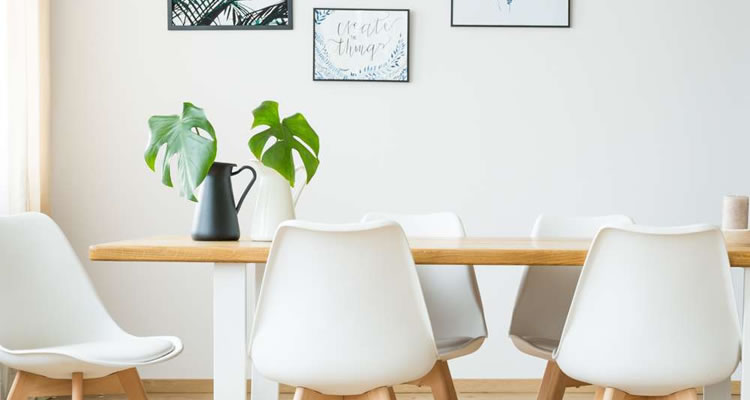
Emulsion is a water-based paint that contains a synthetic resin. This type of paint is normally used on walls and ceilings due to its thick consistency and durability. There are various emulsion choices including:
Matte emulsion
This is a type of flat emulsion that has little to no shine and is normally used on ceilings, walls, and skirting boards. The average price for matte paint is around £2 to £20 per litre.
Pros
The main advantage of matte emulsion is that it can be used to cover imperfections, so there is a need to fix the wall before painting over it. It also provides a more subtle design which fits perfectly with bold colours.
Cons
A downside of a matte finish is that they are hard to clean and tend to hold onto dirt more than other emulsion paints. You must also be careful when cleaning it as you could remove the finish by scrubbing too hard.
Eggshell emulsion
An eggshell has a slight sheen which takes it just above a matte finish on the emulsion shine scale. This type of paint tends to cost around £7 to £15 per litre.
Pros
Eggshell emulsions are perfect for subtle designs as they reflect a small amount of light which is ideal in rooms that are already bright, as it is not overpowering. It is also easy to clean, in comparison to a matte white emulsion paint, as it does not collect much dirt.
Cons
In comparison to glossier paints, eggshell is less durable, which means it will not protect the surface as well as other emulsions do.
Silk emulsion
This type of emulsion offers a mid-level sheen which creates more of a glow than a shine and is normally the best white paint for walls. Silk emulsion tends to be priced at £4 to £8 per litre.
Pros
Silk emulsion is ideal for living areas which have limited light as it can brighten up the space without making it too striking. It is also very easy to clean and maintain, as silk paints tend to be washable.
Cons
A disadvantage of silk walls is that they tend to show up imperfections, as this type of emulsion does not hide them well.
Satin emulsion
Satin emulsion has a similar sheen to silk; however, it is normally used on wood rather than walls. This emulsion costs about £2 to £9 per litre.
Pros
Unlike silk, satin emulsion does hide imperfection on wood surfaces, which is great if you are just planning to spruce up your wood furniture with a new colour. This type of paint is also very durable, so the colour should last a long time.
Cons
It may be harder to apply a satinwood emulsion as it tends to be slightly thicker than other emulsions and will, therefore, require more coats.
High gloss paint
This is the highest sheen available in emulsion paints and is ideal for dark spaces that are lacking light. This type of emulsion is typically priced at £9 to £16 per litre
Pros
High-gloss emulsion is one of the most durable paint options available, which is why it is used in high traffic areas. It is also very easy to clean, as it does not attract dust like flatter emulsions do. There are also a variety of gloss paint colours available, which will help you customise your space to your own tastes.
Cons
The main disadvantage of gloss paint is that it clearly shows damage due to it being a light reflecting paint that enables it to highlight imperfections. It is also not ideal for outdoor use, as you would need the walls to be thoroughly prepared to avoid cracks or scuffs shining through.
Best Gloss Paint
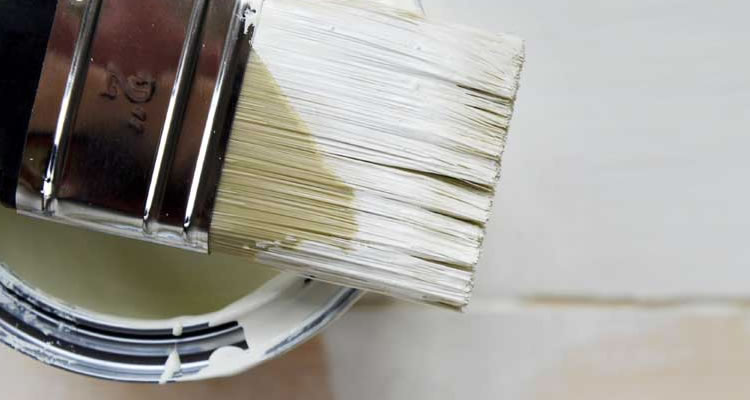
Gloss paint creates a high shine on surfaces by creating a mirror-like effect that can bounce off light. There are various gloss paints on the mark, although the following are some of the most popular options.
Johnstone’s One Coat Gloss Paint
This budget gloss paint can be used on wood and metal surface. It is ideal for anyone on a budget, as it costs around £7 per litre.
Pros
This low-budget gloss paint is the perfect solution for touch-ups with its self-priming formula which can help you save money on your decorating project. It is also very easy to apply and does not require a primer, which should cut down your painting time.
Cons
Due to its thick consistency it cannot be applied without a paint sprayer, so you may have to spend more time using a paint brush or roller. It is also not the best option for un-primed wood, as it will not protect it and the paint may not last long.
Rust-Oleum Universal Gloss Paint
This paint is a two-in-one primer which can be used for a variety of surfaces including ferrous and non-ferrous metals, ceramic, masonry, and wood. You can purchase this for around £40 to £60 per litre.
Pros
This is one of the best gloss paints for indoor and outdoor use as it is easy to apply and can be used on almost any surface. It also touch dries in just 2 hours and can be handled after around 8 hours. You can also choose from a variety of gloss paint colours to make your space stand out.
Cons
As this is an oil-based gloss paint it does contain volatile organic compounds which are unsafe to use in enclosed spaces, so you will need to use it outside or ventilate your home properly while using it. The product may also change colour once when it is cured, so make sure you test it first.
Dulux Quick Dry Gloss
This water-based gloss paint offers a great aesthetic for a variety of surfaces, while also helping you lower your carbon footprint with its low odour and lack of VOCs. This paint is priced at around £10 per litre.
Pros
This gloss paint has a high coverage power, which means you will not have to apply more than two layers. It also dries fast, so you can handle your surface quickly. The surface also very easy to clean, as it is washable and also has a non-yellowing feature.
Cons
If you are redecorating a wall which previously had oil-based paint, it may be difficult to adhere the gloss paint to the surface. You should also be wary of paint sticking to the brush as this can cause marks in the paint.
Best Satin Paint
Satin or satinwood paint has a slight sheen to it in comparison to matte paints, and it is also one of the most durable paint options. There are various options available including:
Dulux Quick Dry Satinwood
This is water-based satinwood paint which is available in 20 shades. You can purchase Dulux Quick Dry Satinwood from a local DIY retailer for around £16 to £25 per litre.
Pros
This paint offers an aesthetically pleasing mid-sheen finish which is ideal at enhancing surfaces, while also covering up any imperfections or damage. It is very easy to apply and does not always require a primer. The paint is also eco-friendly due to its lack of odour and low-VOCs.
Cons
The main issue with this paint is that it takes around 3 coats to achieve full coverage, so the job may be time-consuming. It is also not adequate for heated surfaces such as a radiator as it is not robust enough to cope with the temperature.
Crown Quick Dry Satin
This is another water-based paint which offers a simple and soft sheen and can be used on a variety of surfaces. The average price for this type of paint is £12 to £15 per litre.
Pros
The main advantage of this type of paint is that it features breathe-easy technology that is 99% solvent-free. This means it is safe to use indoors and even in poorly ventilated rooms. It also has non-yellowing abilities which enables white emulsion paint to stay whiter for longer.
Cons
If you are painting over a dark colour, then you will need to apply additional coats to ensure that full coverage is achieved. You will also need to apply the product quickly as it tends to stick to the brush which can cause unsightly marks.
Dulux Diamond Satinwood
This is a highly durable water-based paint which is perfect for high-traffic areas. The Dulux Diamond Satinwood paint costs around £18 to £25 per litre.
Pros
One of the many benefits of this paint is that it is resistant to scratches, grease and stains, so you will spend less time cleaning your stairs or walls. It is also very easy to apply and also dries quickly without releasing any overpowering toxins.
Cons
Before applying this paint, you will need to spend a significant amount of time preparing the surface, as the paint will not stick properly if the wall is dirty or old paint is stopping it from adhering properly.
Best Chalk Paint
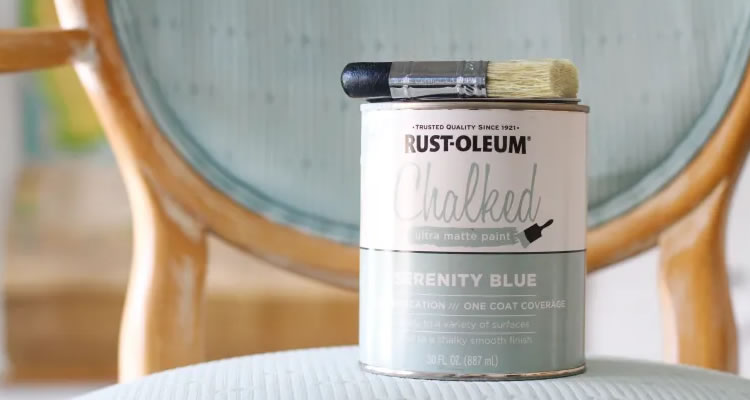
Chalk paint is a type of decorative matte paint which is used in homes that favour a rustic and vintage style. There are various chalk paint products available to purchase, although the following are listed as the top-rated.
Hemway Chalk Paint
This matte-finish chalk paint is ideal for DIYers who are planning to paint walls, furniture, and woodwork. You can purchase the Hemway Chalk Paint for just under £40 per litre.
Pros
This paint is the perfect option for first time DIYers, as it is extremely easy to apply, does not require a primer and can also be used on a wide range of surfaces. It also provides excellent coverage and has a quick drying process, so you won’t have to wait all day for it to cure.
Cons
One of the problems with this paint is if you are changing a light colour to a dark colour, then it may take more than 2 coats to achieve the shade you want.
Shabby Chic Chalk-based Furniture Paint
A chalky paint with a water-based solution is the perfect choice for wood, metal, stone, plaster, brick, and plastic. This paint is available to buy from £18 to £70 per litre.
Pros
As this chalk paint is water-based it is completely safe to use indoors due to its low odour and lack of toxins. You can also benefit from the thirty-six different colours that are available, which will allow you to create a unique design.
Cons
One of the downsides of using this paint is that the colours may come out differently once they are applied, so you will definitely need to test them out first. It also has a low coverage power, so you will need to apply a few coats for it to look consistent.
Best Paint Applicators
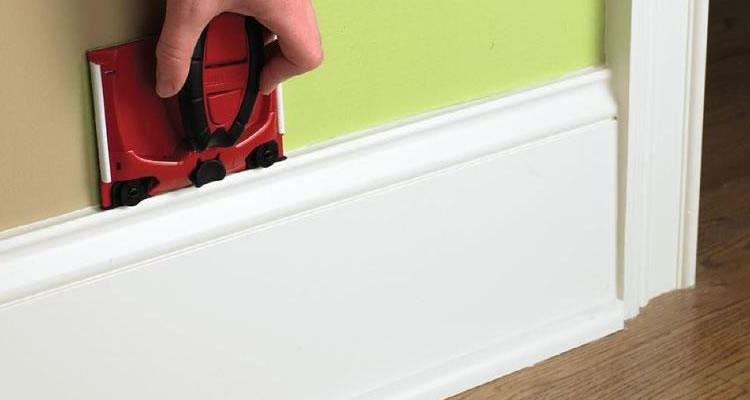
Another important thing to consider when painting is the type of applicator you use, as this will determine how long the job will take as well what the finish looks like. To help you choose the right tool, take a look at the below paint applicators.
Paintbrushes
Using a paintbrush is one of the most popular options for painting projects. There are a variety of paintbrushes to choose from including:
Synthetic fibre paint brush
A synthetic fibre paint brush is manufactured to make it look exactly like a natural fibre paint brush, although it has varying functions and tends to work better with water-based paints on plastic and metal surfaces. The cost of a synthetic fibre paint brush is around £2 to £10.
Pros
Synthetic paint brushes do not hold as much water as real hair paint brushes, which makes them the perfect choice for applying water-based paint. This type of brush does not absorb the paint, which means you will lose less paint, offering you more value for your money.
Cons
It may take more time to apply the paint using a synthetic paint brush, as unlike natural fibre paint brushes it does not split. It is also not ideal for oil-based, as it is much harder to apply unless you have a synthetic brush that is compatible with oil paints.
Natural fibre paint brush
A natural fibre paint brush is made up of real hair and is normally used for oil-based paints, wood stain, and varnish for walls, as well as wood and glass furnishings. The average cost of a natural paint brush is normally around £5 to £30.
Pros
Natural paint brushes allow to you apply paint quickly as the end of the paintbrush is capable of flagging which means you will only have to use fewer brush strokes in comparison to synthetic fibre brushes. It is also ideal for applying varnish and shellac paint.
Cons
Natural fibre brushes should not be used on latex or water-based paints, as the natural bristle absorbs the water and causes it to swell up. Natural fibre brushes are also not environmentally friendly as they are made of animal hair.
Rollers
An alternative to paintbrushes is a roller which is normally used on large flat surfaces such as walls or ceilings. There are various types of paint roller including:
Manual roller
One of the most common paint rollers is a manual roller which usually has a handle along with handle extensions to help you reach higher areas. Manual rollers tend to cost around £3 to £12.
Pros
Manual rollers have the ability to reach high surfaces such as the ceiling, so you don’t have to worry about avoiding any areas and you may not even need a ladder. They are also very to use and allow better access than paintbrushes.
Cons
When using a manual roller, you need to watch out for dripping, as this type of roller does build up a significant amount of paint which may drip down your walls and ruin your paintwork. They are not the best choice for small areas, as they not be able to reach in the same way that a paintbrush would.
Foam roller
A foam paint roller is made up of compressed foam which is moulded into a tube shape. This is an ideal choice if you are painting regular emulsion on a smooth plastered wall. The cost of a foam roller is around £3 to £5.
Pros
Foam paint rollers are a great choice, as the foam absorbs paint easily, and when applied to a smooth wall it will ensure it is covered evenly. The high absorption level also enables you to use a roller on large surfaces, which will reduce the amount of painting time.
Cons
You should avoid using a foam roller with normal latex paints as it causes air bubbles within the paint caused by the spongy texture of the foam. These air bubbles can also burst, leaving an unattractive cratered look.
Short-haired mohair roller
This type of paint roller is made up of Angora wool and can be used for the majority of surfaces or paint types, so it is ideal for numerous projects. The cost of a short-haired mohair roller is around £2 to £6.
Pros
Using a short pile mohair roller means there is less chance of splatter on your walls or surfaces and it is basically lint-free which means it will make your walls easier to clean. It will also ensure that your painting project is smooth and free from brush strokes.
Cons
The main issue with this type of paint roller is that the materials used are not environmentally friendly, as the mohair comes from Angora goats. It may not be the best option for textured surfaces, as it will not provide the right coverage.
Long-haired mohair roller
A long-haired mohair roller is made of the exact same material as a short-haired mohair roller, the only difference is that the roller pile is longer. This type of roller tends to cost around £5 to £8.
Pros
Unlike short pile mohair roller, long pile models are ideal for textured surfaces such as walls and aertex ceilings, as it can provide full coverage on water-based paints. A longer pile also allows for better distribution of paint which will cut down your painting time.
Cons
This roller is not the best choice for smooth surfaces, as it may create unnecessary marks. It is also not ideal for oil-based paints, as it does not absorb it as well as water-based paint.
Paint pads
A paint pad is another type of paint applicator which is used by homeowners to create smooth and aesthetically pleasing walls, cabinets, surfaces and more. This is a rectangular-shaped paint pad with a flat surface which features a handle, a foam front and short bristle. Paint pads tend to cost around £4 for a single paint pad and up to £16 for a paint pad set which includes a paint tray.
There are various advantages and disadvantages of using a paint pad including:
Pros
One of the main benefits of using a paint pad is that they are extremely easy to use due to their flat shape which enables you to get a smooth, even finish. Their shape also allows them to take on more paint in comparison to brushes, so it will speed up the painting process, especially for ceiling projects.
Cons
One of the main problems with paint pads is that it cannot hold as much paint as a roller, so it will need to be reloaded regularly. You may also need to apply an extra layer as it may not provide you with the coverage you need.
Best Paint Removers
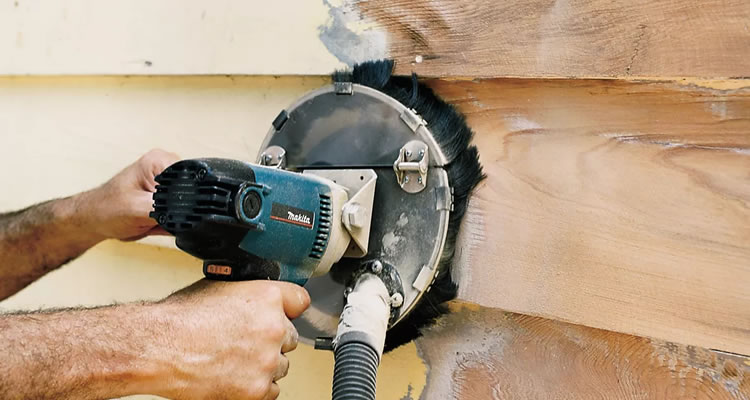
If you wish to remove paint from surfaces as you do not like the colour or it is starting to flake away, then you should consider purchasing one of the following paint removers.
Multi-purpose paint stripper
Multi-purpose paint remover is ideal for almost any surface including metal, brick and wood. This type of paint costs around £7 to £15 per litre.
Pros
The most obvious benefit of a multi-purpose paint stripper is that it can remove paint from virtually any material, so it can be used for multiple projects. This will enable you to get great value for your money while redecorating.
Cons
Multi-purpose paint stripper may not be as efficient as other paint strippers that are used specifically for one material. This type of paint stripper can also be hard to apply, as it is usually thick and can take a while to work.
Liquid paint remover
This type of paint stripper is ideal for wood and masonry surfaces and tends to cost around £6 to £8 per litre.
Pros
The great thing about a liquid paint remover is that you can use it on your walls and cupboards as it clings to vertical surfaces well. It is also ideal for furnishings which have grooves, as the liquid paint remover can access it easily without missing any spots of paint.
Cons
When using a liquid paint remover on wood, you may want to protect the area first, as the paint remover can seep into the wood and cause it to discolour once its cured. This can also be a messy job, so make you cover any new flooring or furniture to protect them.
Paint and varnish stripper
This type of paint is ideal for all paint and varnish types and can remove paint from glass, wood, stone and metal. The average price of paint and varnish stripper is around £2 to £8 per litre.
Pros
Paint and varnish stripper tend to peel off easily, which will allow you to get started on your decorating project. This type of product does not penetrate as much as others so there is less chance of any damage.
Cons
Some paint and varnish strippers can be toxic and release strong odours, so you will need to ventilate your house to prevent bad toxins entering your home. If remove a water-based paint, it may not be as effective in comparison to solvent-based paint.
FAQs
Q: How long after plastering can you paint?
A: If you are painting a newly plastered wall, then you should wait at least 4 days before painting, as this will allow the plaster to dry thoroughly. To ensure your walls stay in good condition, you may want to wait up to one before painting, as your walls will be completely dry at this point.
Q: What is acrylic paint?
A: Acrylic paint is made up of pigments and acrylic polymer emulsion. This type of paint dries quickly and is also water-soluble although it actually becomes water-resistant once it is completely dry. Acrylic paint is one of the most durable paint types which does not fade over time.
Q: What is paint best for painting paving stones?
A: To ensure your paving does not crack, you should consider using waterproof concrete paint which has sealing qualities. This prevents a build-up of water, salt, grease and oil. You can also use exterior paint that is made of latex, water-based, or oil-based, as this can withstand high levels of foot traffic.
Q: What is the best paint stripper?
A: If you want to remove old paint, you could consider using an electric paint stripper gun to remove stubborn paint, along with a multi-surface paint or varnish stripping solution. Some of the best paint stripper chemicals include Polycell maximum strength paint stripper, Home Strip paint stripper, and Rustin’s Strypit paint and varnish stripper.
Q: How much paint do I need?
A: The amount of paint you need will depend on the application, as well as the type of paint you plan to use. For example, if you are planning to paint a 60m2 room with average emulsion paint you would need around 5 litres to cover one coat of white paint. While exterior walls measuring 30m2 with eggshell paint would require 2.5 litres per coat.
Q: What is eggshell paint?
A: Eggshell paint is one of the most hard-wearing options which offers a matte sheen similar to that of an actual eggshell. This is popular in modern homes, where the shabby-chic style is used. It is easy to apply to plasterboard, as well as metal and wood, so can be used for almost any paint job.
Q: How long does it take to paint a room?
A: On average, it should take around 8 to 9 hours to paint a regular-sized room measuring 12’ x 12’, although this will depend on the type of paint you choose, as some paint products require more care than others.
Q: How long does spray paint take to dry?
A: Spray paint takes to take around 10 to 15 minutes to dry, however, the drying time will depend on the material is applied to, as it can take up to 24 hours for spray paint to fully dry on glass, while on plastic is can dry thoroughly in just 3 hours.
Q: What is primer paint?
A: A primer paint or undercoat is typically used before applying normal paint. This is used to ensure that the paint sticks to the surface properly, allowing it to last longer and also protects the material that the paint is applied to.
Q: Are paint fumes harmful?
A: Paint fumes are not particularly harmful; however, you should consider wearing a mask and goggles especially when using a paint that contains volatile organic compounds (VOCs) can cause headaches, dizziness, breathing problems and eye irritation. To prevent these issues, you should try to purchase paint that does not contain VOCs, as this will reduce health issues as well as helping to maintain good air quality.
Sources
- https://www.rawlinspaints.com/blog/faqs-painting-upvc-windows-doors/
- https://www.rawlinspaints.com/blog/how-to-paint-woodstained-or-varnished-surfaces/
- https://www.rawlinspaints.com/blog/the-difference-between-damp-proof-paint-and-anti-condensation-paint/
- https://www.wikihow.life/Paint-Wooden-Furniture
- https://www.wikihow.com/Paint-an-Outdoor-Concrete-Patio
- https://www.wikihow.com/Paint-on-Plastic
- https://www.realhomes.com/advice/how-to-paint-your-stairs-ideas-and-tips
- https://www.realhomes.com/buying-guides/the-best-paint-strippers
- https://www.realhomes.com/advice/how-to-paint-a-house-everything-you-need-to-know-inside-and-out
- https://www.realhomes.com/advice/how-to-paint-tiles
- https://www.housebeautiful.com/home-remodeling/diy-projects/a28007575/best-fabric-paints/
- https://www.housebeautiful.com/design-inspiration/a27729301/water-based-paint-vs-oil-based-paint/
- https://www.housebeautiful.com/home-remodeling/diy-projects/a28173281/flat-paint/
- https://www.doityourself.com/stry/5-best-uses-for-a-foam-paint-roller
- https://www.doityourself.com/stry/4-different-types-of-paint-rollers-explained
- https://www.doityourself.com/stry/how-to-paint-a-steel-staircase
- https://peakprofessionalpainting.com/pros-and-cons-of-using-latex-paint/
- https://www.hamiltondecoratingtools.co.uk/knowledge-room/guides/the-pros--cons-of-water--oil-based-paint/76
- https://willkempartschool.com/what-is-the-difference-between-oils-vs-acrylic-paints/
- https://homeguides.sfgate.com/kind-paint-should-use-bathroom-ceiling-84566.html
- https://homeguides.sfgate.com/foam-roller-vs-nap-roller-using-latex-paint-74917.html
- https://www.sandlotscience.com/best-paint-stripper-for-wood/
- https://www.ehow.com/about_5184746_kind-paint-can-used-fabric_.html
- https://www.ehow.co.uk/way_6030947_paint-pad-techniques.html
- https://peakprofessionalpainting.com/pros-cons-gloss-paint/

